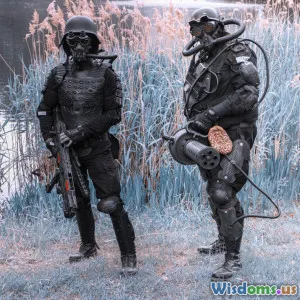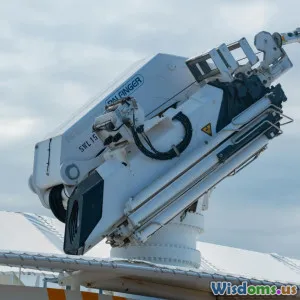
Global Trends in Military Technology
8 min read Explore the latest advancements in global military tech and future weapons shaping modern warfare. (0 Reviews)
Global Trends in Military Technology: Transforming Future Warfare
In an era where technological advancements redefine conventional paradigms, military technology stands at the forefront of innovation. With unprecedented growth in artificial intelligence (AI), robotics, cyberspace strategy, and advanced weaponry, global military initiatives are being guided not just by traditional doctrines but by a forward-thinking approach to combat. Exploring the latest trends sheds light on how nations prepare for modern warfare and the future of security.
The New Age of AI in Warfare
Perhaps the most significant trend in military technology is the increasing incorporation of artificial intelligence. Military AI is no longer confined to science fiction; it is now an integral part of strategy.
AI-Powered Decision Making
AI technology assists in rapid decision-making processes in combat environments. For example, projects like the U.S. Department of Defense's Project Maven, use machine learning to improve drone surveillance and enhance threat detection. By automating data analysis, these systems provide military planners with invaluable insights rapidly, improving their decision-making capacity.

*Fig. 1: AI-driven military systems analyze data to improve tactical decisions.
(Source: Author’s compilation)
Autonomous Systems
Moreover, the integration of AI extends to autonomous vehicles. Unmanned Aerial Vehicles (UAVs) and autonomous combat ground vehicles are becoming prevalent on the battlefield. The Taranis drone, developed by BAE Systems, is capable of flying without human input and is designed for deep strike missions, demonstrating how autonomy may eventually replace certain human roles in warfare.
Ethical Considerations
The growing use of AI raises ethical debates about accountability in warfare. The question of who is responsible for actions taken by AI systems—whether they be military officials or the developers—opens discussions about the moral implications of removing human judgment from combat situations.
The Rise of Robotics and Automation
As military technology evolves, robotics and automation play pivotal roles, enhancing operational capabilities and efficiency. Robotics extends from logistics assistance to front-line support.
Enhancing Logistics
Robots are increasingly employed for logistics in operations. For instance, the Pentagon’s Logistics Command and Control initiative utilizes drones for transport in challenging environments. This not only reduces the risk to personnel but increases mission responsiveness by delivering supplies and equipment efficiently to frontline personnel.
Ground Warfare Robotics
Tactical robots like Boston Dynamics’ Spot and MARS (Multi-functional Utility/Logistics Equipment) provide ground-specific maneuvers in combat zones. Equipped with sensor technology, they easily identify threats in potentially hazardous areas before human soldiers enter. Sustaining a safer operational environment is a primary outcome of this technology.
Cyber Warfare: The New Frontier
In the realm of military technology, cyberspace has emerged as a new battleground. Cyber warfare tactics can cripple nations without ever launching a single physical attack.
Increasing Vulnerability
The U.S. Cyber Command has warned that threats from nation-states like Russia and China exemplify a sophisticated level of cyber warfare. Cyberattacks such as the 2016 Democratic National Committee breach exemplify the kind of vulnerabilities nations face.
Cyber Defense Strategies
Programs such as the U.S. Army's Cyber Security Strategy 2019-2024 are being developed to bolster defenses, focusing on detecting, diagnosing, responding to, and recovering from security incidents. Emerging technologies, such as blockchain, are sought after for secure information transfer, thereby shielding systems from tampering and attack.
National Security Reorientation
Governments are adapting their national security models to incorporate cyber protection. This includes increasing funding for cyber defense capabilities, recruiting skilled experts, and training troops in cybersecurity protocols. In 2020, the U.S. reported increased defense budgets, indicating a shift towards enhancing these advanced tech fronts.
Space: The Final Frontier of Warfare
Outer space is becoming increasingly crucial in military operations, with surveillance, navigation, and communication systems depending on satellite networks to be operational.
Militarization of Space
Countries like the U.S. and China are investing heavily in space military capabilities. The establishment of the U.S. Space Force demonstrates the acknowledgment of space as a domain for potential conflicts. The X-37B robotic spaceplane, capable of conducting secret missions, emphasizes this new distribution of military assets into orbit.
Satellite Defense Systems
The burgeoning reliance on satellites also raises the stakes for defense against potential threats targeting these assets. Terminology such as ASAT (Anti-Satellite Weapons) emerges as certain nations explore offensive strategies to incapacitate enemy satellite networks effectively.
Emerging Technologies: A Glance into the Future
As military tech evolves rapidly, multiple cutting-edge technologies are at play. Understanding trends aids assessment of upcoming changes to global military dynamics.
Hypersonic Weapons
Hypersonic weapons, capable of flying at speeds exceeding Mach 5, draw significant attention for their ability to evade missile defense systems. Nations such as Russia with Zircon and the U.S. testing prototype systems establish a new arms race. Their small reaction times can allow these munitions to strike intentions unexpectedly, challenging traditional defense frameworks.
Directed Energy Weapons
Laser technology has progressed significantly, evidenced by programs like the U.S. Navy’s Laser Weapon System (LAWS). Laser systems beam light at high intensity to disable threats. As effective deterrents, they provide cost-efficient solutions against drones and small boats.
Conclusion
The landscape of military technology and future weapons is not merely defined by advancements but rather the transformative implications that each innovation carries on global security dynamics. As nations harness technologies from AI to drones, the ethical, strategic, and operational frameworks guiding their deployment become paramount. It remains essential for military entities, policymakers, and the general public to engage with these colossal shifts, ensuring they align with global security objectives and ethical standards. The future of warfare is now, and embracing these innovative trends will dictate the balance of power in an increasingly complex world.
Understanding military technology is crucial as these trends reshape defense policies and strategic considerations worldwide.
Rate the Post
User Reviews
Popular Posts

















